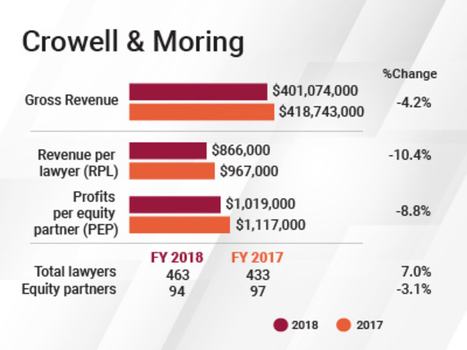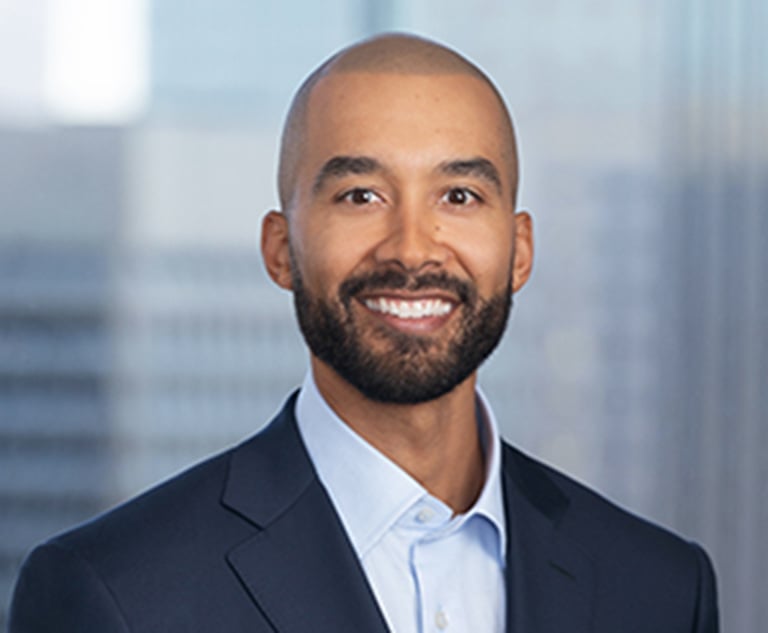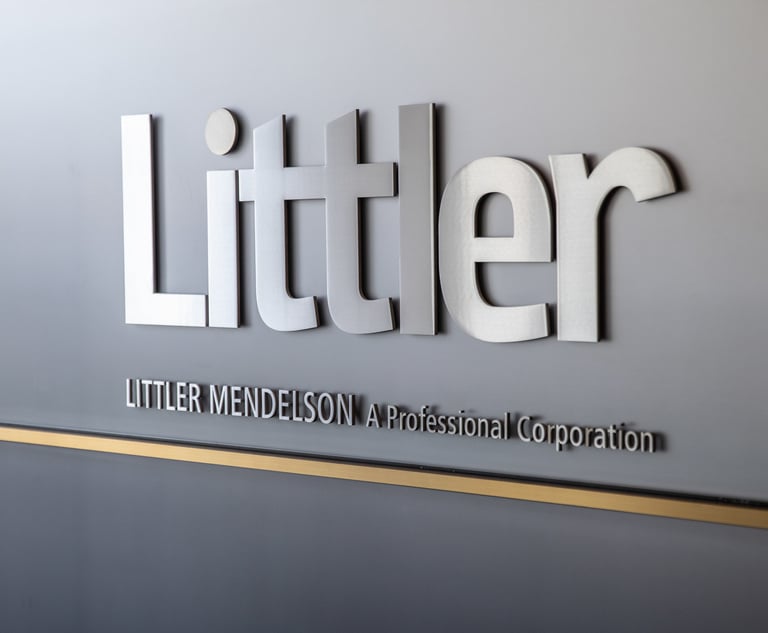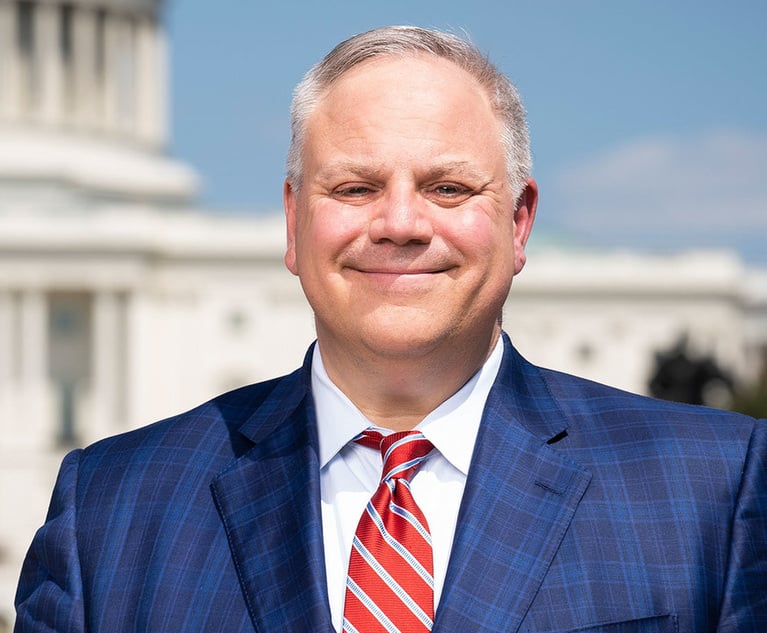Crowell Sees Revenue Drop, Rebalancing After Big Gains
Chairman Phil Inglima said the firm surpassed its own budget and revenue expectations last year.
March 15, 2019 at 03:31 PM
6 minute read
The original version of this story was published on National Law Journal
 Phil Inglima of Crowell Moring. (Courtesy photo)
Phil Inglima of Crowell Moring. (Courtesy photo)
Crowell & Moring saw a 10 percent slide in revenue per lawyer in 2018, with head count on the rise and windfalls that buoyed the firm's bottom line in recent years receding further in the firm's rearview mirror.
Revenue per lawyer dropped by more than $100,000 to $866,000, as the firm added 30 total lawyers—a 7 percent gain—and gross revenue dipped 4.2 percent to $401 million. Profits per equity partner also declined nearly $100,000 in 2018, down 8.8 percent year-over-year to $1.019 million.
Philip Inglima, the firm's chair, described the declines as a natural rebalancing after some unique assignments for the firm and a “robust contingency docket” helped produce its best years ever in 2016 and 2017.
 Inglima said in 2016 the firm benefitted from significant contingency proceeds in a claim against the government brought by a client of the firm's government contracts group. (That year the firm's revenue rocketed up 20 percent, with partner profits up a whopping 40 percent.) In 2017, Crowell won a $680 million judgment against the Sudanese government for families of Americans killed in the 1998 bombings at U.S. Embassies in Kenya and Tanzania, and successfully pushed in 2017 for the creation of a billion-dollar congressionally mandated fund to pay victims of state-sponsored terrorism.
Inglima said in 2016 the firm benefitted from significant contingency proceeds in a claim against the government brought by a client of the firm's government contracts group. (That year the firm's revenue rocketed up 20 percent, with partner profits up a whopping 40 percent.) In 2017, Crowell won a $680 million judgment against the Sudanese government for families of Americans killed in the 1998 bombings at U.S. Embassies in Kenya and Tanzania, and successfully pushed in 2017 for the creation of a billion-dollar congressionally mandated fund to pay victims of state-sponsored terrorism.
“Those aberrations make it look like things perhaps aren't as great over 2018, but in fact we surpassed our own budget and expectations for revenue,” Inglima said. “We were thrilled to once again surpass $400 million in revenue, which required growth in our base business. And we had the largest single year growth in our base ever.”
Inglima defined the firm's base business as the product of hours billed, fixed fee work and other work, which he said rose $25 million last year. Matters driving that growth included Crowell's representation of AT&T in its merger with Time Warner, its restructuring work for Key Safety Systems [now Joyson Safety Systems], and serving as antitrust counsel for United Technologies in its $30 billion of Rockwell Collins. The firm also added a digital transformation practice in April, and it has touted its partnership with HP as its primary outside counsel for 3D printing.
Inglima said Crowell's contingency docket was “modestly increasing” simultaneously on the back of the firm's affirmative recovery practices.
“I think I might have referred to it as frosting on top of the cake. Well, it's a thicker layer than to simply say frosting,” Inglima said. “Our greater growth plan is on the base business side and most of the talent additions that we're doing are fully aligned with that.”
Crowell's plans appear to have crystallized since its change in leadership in 2017. Angela Styles was voted out of the firm's top position after one term and quit the firm in October 2017, joining Bracewell. She then left Bracewell for Akin Gump Strauss Hauer & Feld earlier this year.
Inglima said in 2017 the firm was pursuing a growth strategy that was “more modest,” but last year it “attached a greater ambition” to its growth goals that it expects to pay dividends in 2019 and 2020.
Among lateral hires, Crowell brought on international trade partner David Stepp last year in Los Angeles, a market that the firms aims to expand into further in 2019. Stepp hailed from Bryan Cave Leighton Paisner, and six months later the firm added a 10-lawyer international trade and regulatory team from Bryan Cave. The group is technically based in Los Angeles, but the team's roots are in the Bryan Cave exodus in Asia, and Crowell now intends to open an office in Shanghai, which will serve as its first office in Asia.
The firm is aiming to expand in all its locations, but Inglima said its “greatest aspiration for growth this year [is] in San Francisco.” He said the firm expects to continue growing in London and New York as well. In 2019, Crowell has already added a four-lawyer team in London from Squire Patton Boggs.
Prior to Inglima's time as chair, Crowell considered merging with New York-based Herrick Feinstein. Inglima said the firm is continuing to evaluate options in New York and other markets, but that the firm is “mostly talking about scale between the boutique and the mid-size range,” rather than a major tie-up.
“Whereas some firms, many of our peers, are out combining by supposed mergers of equals, we're more intent on growing by significant but more incremental measures, and right now I would say that you should expect at least to see the kind of growth that we had in 2018 and the beginning of this year to continue quarter over quarter as we go,” Inglima said.
Nearly two years after the merger with Herrick collapsed, he said the firm has become, “more adept at identifying the best places to target.”
“The fact is, especially when folks know that you're in growth mode, lots of opportunities come our way, and we have to be discerning and somewhat discriminating about how we choose to invest our time and effort, and so I think we're becoming better and better about that,” Inglima said. “And I think the results of the last year reflect it.”
(Note: This story was updated to clarify Crowell's counsel relationship with HP.)
This content has been archived. It is available through our partners, LexisNexis® and Bloomberg Law.
To view this content, please continue to their sites.
Not a Lexis Subscriber?
Subscribe Now
Not a Bloomberg Law Subscriber?
Subscribe Now
NOT FOR REPRINT
© 2025 ALM Global, LLC, All Rights Reserved. Request academic re-use from www.copyright.com. All other uses, submit a request to [email protected]. For more information visit Asset & Logo Licensing.
You Might Like
View All

Three Akin Sports Lawyers Jump to Employment Firm Littler Mendelson

Brownstein Adds Former Interior Secretary, Offering 'Strategic Counsel' During New Trump Term
2 minute read
Trending Stories
- 1Pa. High Court: Concrete Proof Not Needed to Weigh Grounds for Preliminary Injunction Order
- 2'Something Else Is Coming': DOGE Established, but With Limited Scope
- 3Polsinelli Picks Up Corporate Health Care Partner From Greenberg Traurig in LA
- 4Kirkland Lands in Phila., but Rate Pressure May Limit the High-Flying Firm's Growth Prospects
- 5Davis Wright Tremaine Turns to Gen AI To Teach Its Associates Legal Writing
Who Got The Work
J. Brugh Lower of Gibbons has entered an appearance for industrial equipment supplier Devco Corporation in a pending trademark infringement lawsuit. The suit, accusing the defendant of selling knock-off Graco products, was filed Dec. 18 in New Jersey District Court by Rivkin Radler on behalf of Graco Inc. and Graco Minnesota. The case, assigned to U.S. District Judge Zahid N. Quraishi, is 3:24-cv-11294, Graco Inc. et al v. Devco Corporation.
Who Got The Work
Rebecca Maller-Stein and Kent A. Yalowitz of Arnold & Porter Kaye Scholer have entered their appearances for Hanaco Venture Capital and its executives, Lior Prosor and David Frankel, in a pending securities lawsuit. The action, filed on Dec. 24 in New York Southern District Court by Zell, Aron & Co. on behalf of Goldeneye Advisors, accuses the defendants of negligently and fraudulently managing the plaintiff's $1 million investment. The case, assigned to U.S. District Judge Vernon S. Broderick, is 1:24-cv-09918, Goldeneye Advisors, LLC v. Hanaco Venture Capital, Ltd. et al.
Who Got The Work
Attorneys from A&O Shearman has stepped in as defense counsel for Toronto-Dominion Bank and other defendants in a pending securities class action. The suit, filed Dec. 11 in New York Southern District Court by Bleichmar Fonti & Auld, accuses the defendants of concealing the bank's 'pervasive' deficiencies in regards to its compliance with the Bank Secrecy Act and the quality of its anti-money laundering controls. The case, assigned to U.S. District Judge Arun Subramanian, is 1:24-cv-09445, Gonzalez v. The Toronto-Dominion Bank et al.
Who Got The Work
Crown Castle International, a Pennsylvania company providing shared communications infrastructure, has turned to Luke D. Wolf of Gordon Rees Scully Mansukhani to fend off a pending breach-of-contract lawsuit. The court action, filed Nov. 25 in Michigan Eastern District Court by Hooper Hathaway PC on behalf of The Town Residences LLC, accuses Crown Castle of failing to transfer approximately $30,000 in utility payments from T-Mobile in breach of a roof-top lease and assignment agreement. The case, assigned to U.S. District Judge Susan K. Declercq, is 2:24-cv-13131, The Town Residences LLC v. T-Mobile US, Inc. et al.
Who Got The Work
Wilfred P. Coronato and Daniel M. Schwartz of McCarter & English have stepped in as defense counsel to Electrolux Home Products Inc. in a pending product liability lawsuit. The court action, filed Nov. 26 in New York Eastern District Court by Poulos Lopiccolo PC and Nagel Rice LLP on behalf of David Stern, alleges that the defendant's refrigerators’ drawers and shelving repeatedly break and fall apart within months after purchase. The case, assigned to U.S. District Judge Joan M. Azrack, is 2:24-cv-08204, Stern v. Electrolux Home Products, Inc.
Featured Firms
Law Offices of Gary Martin Hays & Associates, P.C.
(470) 294-1674
Law Offices of Mark E. Salomone
(857) 444-6468
Smith & Hassler
(713) 739-1250









